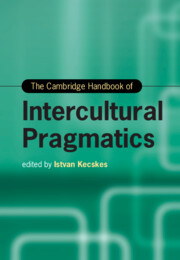Book contents
- The Cambridge Handbook of Intercultural Pragmatics
- Cambridge Handbooks in Language and Linguistics
- The Cambridge Handbook of Intercultural Pragmatics
- Copyright page
- Contents
- Figures
- Tables
- Acknowledgment
- Contributors
- Introduction The Rise of Intercultural Pragmatics
- Part I Theoretical Foundation
- Part II Key Issues in Intercultural Pragmatics Research
- Part III Interface of Intercultural Pragmatics and Related Disciplines
- Part IV Intercultural Pragmatics in Different Types of Communication
- 21 Visual and Multimodal Communication across Cultures
- 22 Intercultural Teamwork via Videoconferencing Technology: A Multimodal (Inter)action Analysis
- 23 Intercultural Communication in Computer-Mediated Discourse
- 24 Intercultural Aspects of Business Communication
- 25 Intercultural Pragmatics in Healthcare Communication
- 26 Academic and Professional Discourse in Intercultural Pragmatics
- 27 The Dynamic Model of Meaning Approach: Analyzing the Interculturality of Conspiracy Theory in Far-Right Populist Discourses
- Part V Language Learning
- Index
- References
21 - Visual and Multimodal Communication across Cultures
from Part IV - Intercultural Pragmatics in Different Types of Communication
Published online by Cambridge University Press: 29 September 2022
- The Cambridge Handbook of Intercultural Pragmatics
- Cambridge Handbooks in Language and Linguistics
- The Cambridge Handbook of Intercultural Pragmatics
- Copyright page
- Contents
- Figures
- Tables
- Acknowledgment
- Contributors
- Introduction The Rise of Intercultural Pragmatics
- Part I Theoretical Foundation
- Part II Key Issues in Intercultural Pragmatics Research
- Part III Interface of Intercultural Pragmatics and Related Disciplines
- Part IV Intercultural Pragmatics in Different Types of Communication
- 21 Visual and Multimodal Communication across Cultures
- 22 Intercultural Teamwork via Videoconferencing Technology: A Multimodal (Inter)action Analysis
- 23 Intercultural Communication in Computer-Mediated Discourse
- 24 Intercultural Aspects of Business Communication
- 25 Intercultural Pragmatics in Healthcare Communication
- 26 Academic and Professional Discourse in Intercultural Pragmatics
- 27 The Dynamic Model of Meaning Approach: Analyzing the Interculturality of Conspiracy Theory in Far-Right Populist Discourses
- Part V Language Learning
- Index
- References
Summary
Successful communication – whether relayed verbally, visually, or in any other mode or mode-combination – crucially depends on cooperation between sender and recipient. Relevance Theory assumes that, ceteris paribus, humans are naturally inclined to help each other and therefore attempt to optimize the chance that their fellow creatures understand them. Given the folk wisdom that “a picture tells more than a thousand words,” we may be forgiven for thinking that visual communication, when possible, is always preferable to its verbal variety. We should not underestimate, however, how much background knowledge is presupposed in communication via pictures or other visuals. A visual message may thus misfire because its sender misjudges the background knowledge and values of the envisaged audience. A further complicating factor is that visual (and all other) messages come with varying degrees of commitment to the meaning conveyed, this meaning ranging from being fully explicit, via being strongly or weakly suggested, to being unintentionally transmitted. Unsurprisingly, visual communication is even more challenging when it straddles different cultures. After presenting a bare-bones introduction to Relevance Theory, I discuss a number of exclusively or partially visual messages that involve, in one way or another, intercultural communication.
- Type
- Chapter
- Information
- The Cambridge Handbook of Intercultural Pragmatics , pp. 527 - 551Publisher: Cambridge University PressPrint publication year: 2022
References
- 4
- Cited by

